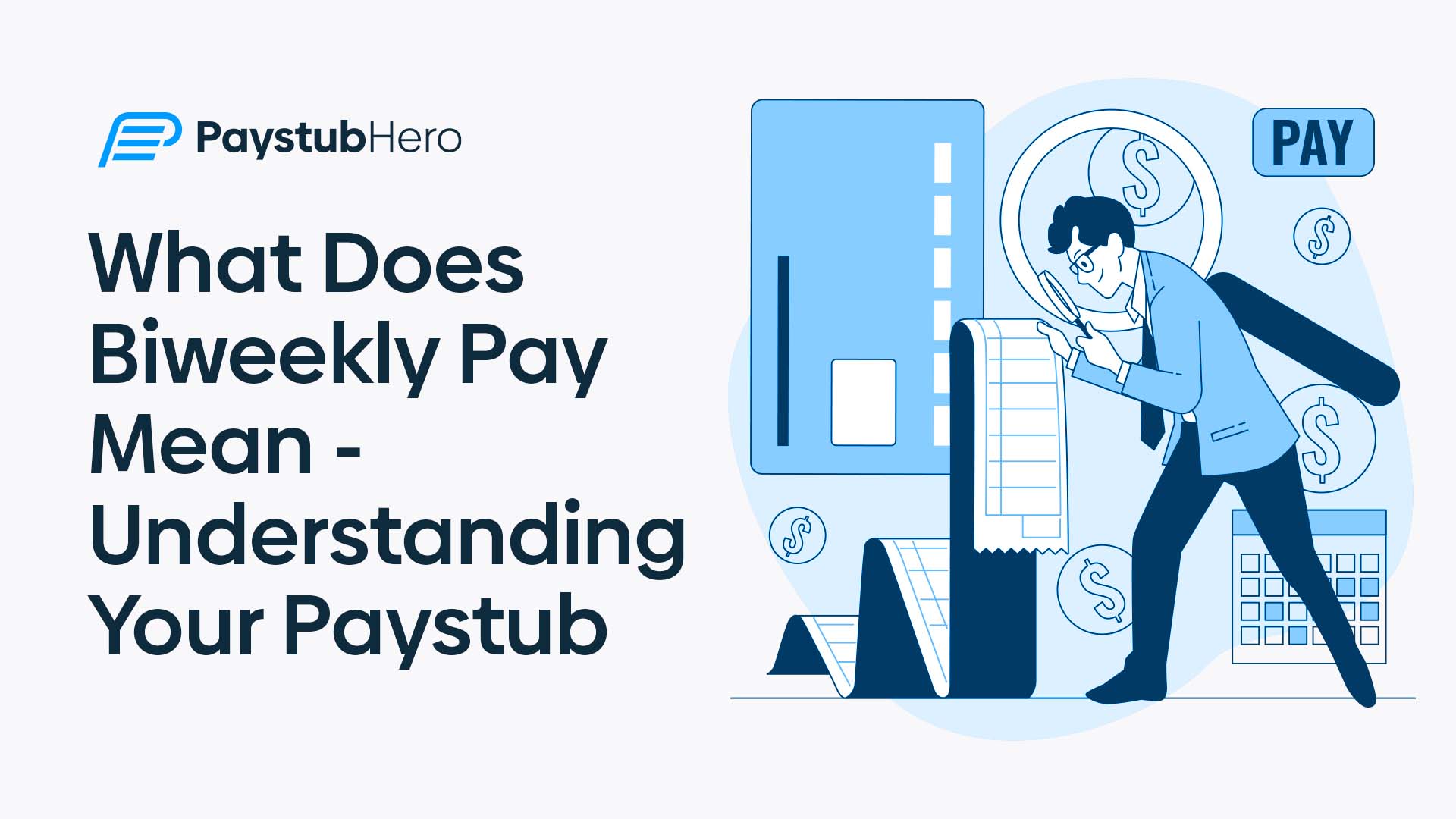When starting a new job, one of the first things you’re likely to be curious about is your paycheck – how much, how often, and through what method will you be paid? Maybe you’ve always been paid monthly and now you’re entering a job where the pay is distributed biweekly.
Or perhaps you’re just starting your working life and terms like “biweekly,” “semimonthly,” and “pay period” sound like a foreign language. Whatever the case, understanding how your pay schedule works is crucial to managing your finances effectively.
Now, if your employer has mentioned that your salary will come biweekly, you might be wondering, “What does biweekly pay mean?” Simply put, biweekly pay means that you receive your paycheck every two weeks, or twice a month. This is quite a common pay schedule, used by many businesses across various industries.
Now that we’ve directly answered the question, let’s delve deeper. Biweekly pay can seem simple at first, but there are nuances to this schedule that can significantly impact your monthly budgeting and overall financial management.
The number of pay periods in a year, the months where you’ll receive an extra paycheck, and how this system differs from other common ones like semimonthly pay are all essential aspects to understand.
In this article, we’ll demystify these terms, providing you with a clear understanding of biweekly pay. We’ll also discuss how to make the most of this payment schedule, and how to read your paystub accurately.
Read on to become a master of your biweekly pay schedule.
Table of Contents
- Introduction: Demystifying Biweekly Pay
- Deciphering Biweekly Pay: An In-depth Look at Your Pay Schedule
- The Difference between Biweekly and Semimonthly Pay: Clarity Amid Common Confusion
- Implications of Biweekly Pay: Pros, Cons, and Its Impact on Your Financial Planning
- Making Sense of Your Paystub: Your Guide to Decoding Payroll Details
- Making Biweekly Pay Work for You: Strategies for Maximizing Your Pay Schedule
- Concluding Thoughts: Embrace the Biweekly Pay Schedule with Confidence
- Ready for Hassle-Free Payroll? Meet Paystubhero
Deciphering Biweekly Pay: An In-depth Look at Your Pay Schedule
Navigating the world of payroll can be confusing, especially if you’re new to it. One of the most common pay schedules is the biweekly schedule, yet not everyone fully understands what it entails.
In the context of payroll, ‘biweekly’ refers to a system where employees receive their salary once every two weeks. This frequency typically results in 26 pay periods in a year. But how does this work exactly? Well, it means that in most months you’ll receive two paychecks. However, two months in the year will yield three paychecks.
For instance, let’s say you begin work on the first Monday of the year. In a biweekly pay schedule, your first paycheck might arrive on the third Monday, covering your first two weeks of work.
From then on, every other Monday would be your ‘payday.’ These ‘extra’ paydays can come in handy for managing unexpected expenses or for saving towards a specific goal.
While the biweekly system is quite common, it is important to note that not all employers use it. Pay frequency can differ from one company to another, and it is always advisable to clarify this detail during the hiring process.
Understanding your pay schedule is an important aspect of personal financial management. The more you know about when and how your pay is calculated, the better prepared you’ll be to manage your money effectively. Armed with this knowledge, you’re well on your way to mastering your finances.
The Difference between Biweekly and Semimonthly Pay: Clarity Amid Common Confusion
Understanding the language of payroll is critical to effective financial planning. Within this language, terms like “biweekly,” “semimonthly,” and “semiweekly” are frequently used, and quite often, they’re mistakenly used interchangeably.
However, each term has its unique implications on the frequency of your pay and ultimately, your annual income.
Let’s dissect these terms:
- Biweekly (what is biweekly?): This term means getting paid every two weeks. Over a year, this schedule typically results in 26 pay periods. In essence, you receive a paycheck 26 times in a year, which could mean three paychecks in two months of that year.
- Semiweekly: This term refers to a system where you get paid twice a week. While it might seem like a dream come true, it’s actually quite rare and often found in specific industries such as hospitality where wages are often calculated on an hourly basis.
- Semimonthly: This means you get paid twice a month, regardless of how many weeks are in that month. Usually, payments are made on set dates, like the 1st and the 15th of every month. Over a year, this results in 24 pay periods, fewer than a biweekly pay schedule.
So, why does this matter? At first glance, the difference between semimonthly and biweekly may seem small, but the impact on your annual income and budgeting can be significant.
While the total salary remains the same, a biweekly schedule could mean two extra paychecks a year compared to a semimonthly schedule. These extra paychecks can provide a buffer for unexpected expenses or opportunities to increase savings.
Getting these terms right and understanding their implications is crucial for accurately anticipating your income, planning your expenses, and optimizing your savings. In essence, a deeper comprehension of these payroll terms can lead to more informed financial decisions.
Implications of Biweekly Pay: Pros, Cons, and Its Impact on Your Financial Planning
As with any pay schedule, biweekly pay comes with its unique set of implications. Being aware of these can help you adjust your budget, synchronize your bill payments, and optimize your savings.
One of the significant benefits of a biweekly pay schedule is the two extra paychecks in the year compared to a semimonthly schedule.
While the total annual salary remains the same, these additional paychecks can help manage monthly expenses, especially if they coincide with larger expenses or financial obligations. It’s like a mini financial boost that comes twice a year – a pleasant surprise to look forward to!
On the other side of the coin, the fluctuating nature of biweekly pay can pose certain challenges. Since the pay is not distributed evenly throughout the year (think of those two extra paychecks), some months you will receive two paychecks, and others you will receive three. This fluctuation can make budgeting a bit more challenging.
If you’re used to a predictable, fixed income every month, adapting to a biweekly schedule might require some time and adjustment. Bills don’t come biweekly – they’re typically due monthly.
So, you’ll need to plan accordingly to ensure you have enough funds to cover your expenses, especially during months when you only receive two paychecks.
Understanding these implications can help you develop an effective budgeting system. By being mindful of when your paychecks arrive and planning your expenses accordingly, you can smooth out the fluctuations inherent in a biweekly pay system.
This way, you’ll be equipped to manage your finances seamlessly, irrespective of when your paychecks arrive.
Making Sense of Your Paystub: Your Guide to Decoding Payroll Details
Your paystub serves as a key to understanding your earnings, deductions, and ultimately, your take-home pay. It may seem like a jumble of numbers and jargon at first, but each section of your paystub has an important role in breaking down how your pay is calculated.
Typically, your paystub will show your gross pay, which is your total earnings before any deductions. If you’re paid biweekly, this figure will represent your earnings for a two-week period.
Your paystub will also list any overtime you’ve accrued, bonuses you’ve earned, and reimbursements for expenses. All these details come together to form your total income for the pay period.
Deductions are a critical part of your paystub. These are amounts subtracted from your gross pay and generally include taxes (federal, state, and local), Social Security, Medicare, health insurance premiums, retirement contributions, and other work-related expenses you may be responsible for.
Each deduction will be listed separately to provide transparency on how much is being taken out and where it’s going.
Your net pay, also known as your take-home pay, is what you’re left with after all deductions are made. It’s the amount that actually lands in your bank account and is yours to budget, save, or spend.
Understanding your paystub becomes even more crucial when there are changes to your pay, such as tax code updates or changes in benefit contributions. Regularly reviewing your paystub ensures you’re being paid correctly, helps you anticipate future earnings, and can serve as a valuable tool for budget planning.
Your paystub also provides crucial documentation for your financial life, from proving income to potential landlords or lenders, to serving as a record when filing your taxes.
In short, taking the time to understand your paystub isn’t just a good financial practice – it’s essential for managing many aspects of your personal finances.
Making Biweekly Pay Work for You: Strategies for Maximizing Your Pay Schedule
Now that you understand what biweekly pay means and have learned how to interpret your paystub, you might be wondering how to best manage this type of pay schedule. With a little strategy, you can transform the unique aspects of biweekly pay into advantages for your personal financial management.
The first step to making biweekly pay work for you is aligning your major bill payments with your paychecks. This means scheduling your rent or mortgage, utilities, and other large expenses to be paid right after you receive your paycheck.
This strategy can help manage cash flow and avoid late payment fees. If your bills’ due dates don’t line up with your paydays, consider contacting your service providers to see if they can adjust your billing cycle.
Next, consider setting up automatic transfers to your savings account or towards debt repayment on your payday. This ‘pay yourself first’ approach ensures that a portion of your income goes towards your financial goals before it can be spent on other expenses.
With a biweekly pay schedule, you’ll be making these contributions 26 times a year, and those additional payments can make a significant difference over time.
Don’t forget about the ‘extra’ paychecks that come two months out of the year. While it might be tempting to see these as a bonus to be spent on luxuries or treats, they provide an excellent opportunity to bolster your financial health. You could use these extra paychecks to build up your emergency fund, pay down debt, or increase your retirement savings.
Finally, keep in mind that budgeting with biweekly pay may require a bit more attention and adjustment than with a monthly pay schedule. Tools like budgeting apps and spreadsheets can help you track your income and expenses and adjust as needed.
In the end, how you manage your biweekly pay schedule is up to you. With an understanding of what biweekly pay means, a clear interpretation of your paystub, and a plan for managing your paychecks, you’ll be well-equipped to make this pay schedule work to your benefit.
Concluding Thoughts: Embrace the Biweekly Pay Schedule with Confidence
Decoding payroll details, especially when it comes to understanding what biweekly pay means, can seem intimidating at first. However, with a clear understanding of the fundamentals, the right approach to managing your paychecks, and a thorough understanding of your paystub, you can navigate the biweekly pay schedule with ease and confidence.
Biweekly pay is more than just a term on your contract – it’s a system that, when fully understood, can be harnessed to optimize your financial planning. By aligning your bill payments with your paydays, leveraging ‘extra’ paychecks to meet financial goals, and staying on top of your paystub details, you can make the most of your biweekly pay.
Remember that your pay schedule is an integral part of your financial life. It’s a tool that influences your monthly budgeting, savings plans, and even your long-term financial stability. So, take the time to truly understand it, ask questions when needed, and plan accordingly.
In essence, comprehending the ins and outs of biweekly pay is a key step towards mastering your personal finances. Armed with this knowledge, you’re not just an employee receiving a paycheck but a savvy individual making strategic financial decisions.
Ready for Hassle-Free Payroll? Meet Paystubhero
If you’re an entrepreneur, freelancer, or small business owner seeking an efficient, affordable payroll solution, look no further than Paystubhero.
Our online software is designed with you in mind. No more complex calculations or confusing paperwork – just enter your company/employee information, and we’ll handle the rest.
At Paystubhero, we understand the value of simplicity, affordability, and efficiency, especially when it comes to payroll. So whether you’re paying biweekly, semi-monthly, or using any other pay schedule, we’ve got you covered.
Try Paystubhero today – because payroll should be as easy as 1-2-3.
Frequent Asked Questions
- Does biweekly mean you get paid for two weeks?
- Yes, biweekly pay means you receive your paycheck every two weeks, typically accounting for your work hours during the preceding two-week period.
- Is it better to be paid weekly or biweekly?
- It depends on individual financial needs and budgeting style. Weekly pay provides a steady cash flow, while biweekly pay can offer two extra paychecks in a year.
- How does biweekly pay work when you first start?
- When you start a job with biweekly pay, your first paycheck will typically come two weeks after your start date, reflecting your earnings during that period.
- How many hours is biweekly pay?
- Biweekly pay typically reflects 80 hours of work for full-time employees (40 hours per week over a two-week period). However, the actual hours may vary depending on overtime or part-time status.








